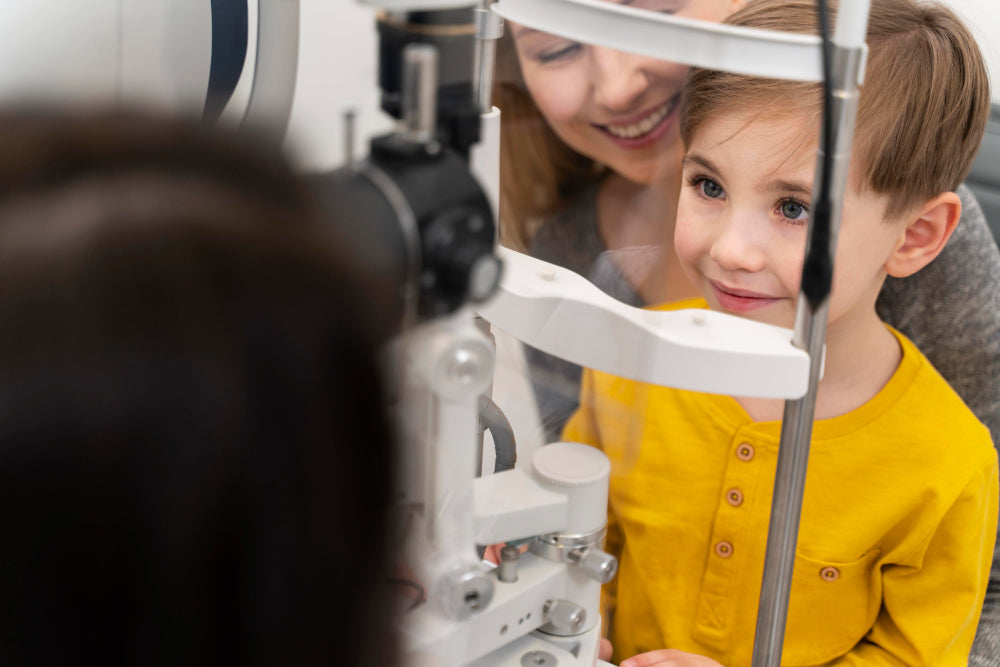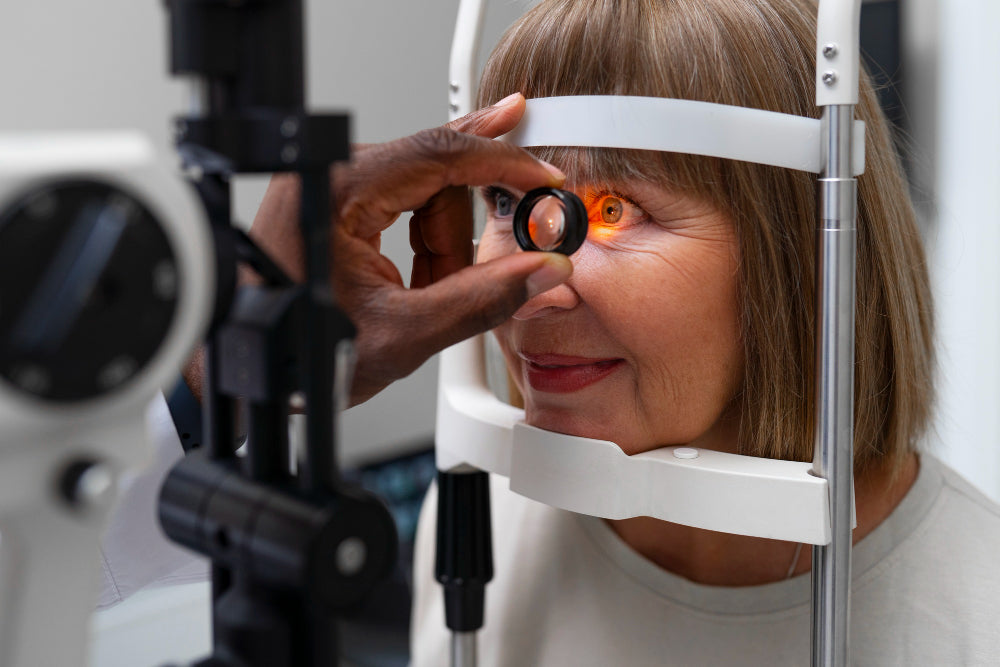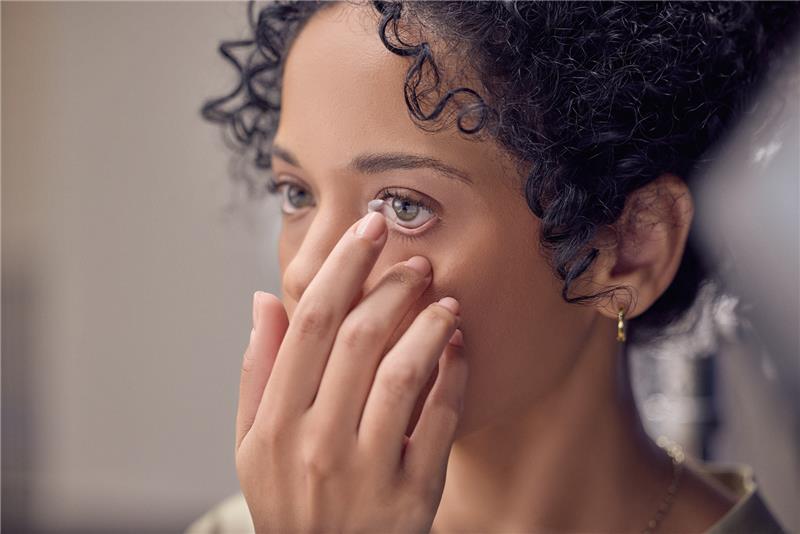As parents, keeping an eye on our children’s health and well-being is a top priority. An often overlooked aspect of this care is the significance of regular eye exams for children.
Vision is essential to a child’s development, learning, and overall quality of life. Knowing when to schedule an eye exam for kids can significantly influence their visual health and academic success, offering them a crucial advantage in their educational journey.
The Eyecare Professionals at Vision Source Rio, with over 90 years of combined clinical experience, recommend infants have their eyes examined between the ages of 6-12 months through our American Optometric Association public service InfantSEE Program. This program is FREE to all infants aged 6-12 months. After that, children should be seen annually starting at age 3 for dilated comprehensive eye exams, unless a parent or loved one suspects a problem prior to 3 years of age. From age 3 to age 10, annual dilated comprehensive eye examinations are recommended. For children 10 years and older the need for dilation is determined by the doctor, provided internal ocular health is assessed with Optomap Retinal Imaging. The exam frequency recommendation remains annual.
Ensuring your child's healthy vision is critical for their development and well-being. Regular eye exams can help identify and address vision problems early, preventing potential complications and ensuring your child can see to learn.
The Significance of Early Eye Exams

Vision issues can profoundly affect a child’s ability to learn, interact, and engage with his or her environment. Early detection of these issues can prevent them from becoming more severe.
Routine eye exams can reveal various vision problems which can interfere with a child's learning and developmental milestones.
When Should a Child Have Their First Eye Exam?

Infants
The American Optometric Association recommends that infants aged 6-12 months be seen for their first eye exam through the InfantSEE program. The InfantSEE program is a national public service offered by optometrists throughout the country whereby infants aged 6-12 months can receive their first eye exam at absolutely no cost. That’s right, that first eye exam is totally free. The InfantSEE program was born out of a challenge issued by former president Jimmy Carter to the American Optometric Association to eradicate amblyopia (lazy eye) which several of his grandchildren suffered from. But what, you may ask, can you ascertain by examining an infant? Believe it or not there are many objective tests that can be performed on a baby. Preferential looking to assess visual acuity, visual fields using light up toys, pupil response to light, looking at the way the eyes line up and work together, assessment of the health of the front of the eyes, dilation and binocular indirect ophthalmoscope to assess the health inside the eyes, and retinoscopy to determine refractive error can all be completed on an infant. The most important things the doctor will be checking for are lazy eye, tumors inside the eye, and significant amounts of refractive error. If significant refractive error is detected upon initial exam, in the vast majority of cases lenses will not be prescribed that day. Infant’s eyes change rapidly, so there is a real need to follow up and confirm refractive error prior to a prescription being written. Since it’s inception, the InfantSEE program has been directly responsible for saving the lives of babies presenting with a deadly form of tumor called retinoblastoma. In all over 18,000 eye and vision conditions have been identified to date as a direct result of the InfantSEE program. You can book an appointment for your baby here with Vision Source Rio’s very own Dr Amanda Estrada who administers the program through our practice.
12 Months to 3 Years
If no significant issues were detected at baby’s InfantSEE exam, we recommend checking the child again at age 3, or prior to starting preschool. If during this interval a loved one or caregiver feels there is a problem that warrants a more timely evaluation, by all means schedule the toddler sooner. Otherwise age 3 is a good time to begin a regular cadence of annual eye exams. A thorough eye exam is crucial during this developmental stage, as children are better able to engage in detailed vision assessments by age three, which aligns with early schooling.
Undetected vision problems can affect a child’s academic and social performance. Comprehensive eye exams during this period evaluate visual acuity, eye coordination, depth perception, internal and external ocular health, pupillary function, peripheral visual fields, as well as ruling out large amounts of refractive error: all essential for academic and personal development. Once again, a toddler’s eyes are developing rapidly, so in most cases if significant refractive error is identified at this exam, a follow up to confirm this finding will be scheduled prior to lenses being prescribed. The doctor is looking for large amounts of refractive error that would significantly impact a child’s vision if left uncorrected. Small amounts of refractive error will not result in a prescription.
4 Years to 10 Years
Between the ages of 4 and 10 is a good time to work into an annual dilated eye exam routine. Your child will most likely experience vision screenings at the pediatrician’s office and by school nurses. However a vision screening is no substitute for a comprehensive dilated eye exam. Here’s why.
The circumstance under which your child’s vision is being “tested” is not a controlled environment. Often times this involves being marched down a busy hallway and asked to read a wall chart from 20 feet. These tests are not well calibrated and the environment is certainly not conducive to cooperation. Children in school screenings listen to their friends read the letters and often repeat the same thing, hoping to avoid a trip to the eye doctor. Even when children can read the letters at distance and/or near, this speaks nothing to the way the eyes work together nor how hard they have to focus, and whether or not they can sustain clear, comfortable singular binocular vision all day long in the classroom. Dilation is required in children to completely assess their refractive state and this is simply not possible in a screening environment.
Children with lazy eye as a result of latent hyperopia, or hidden farsightedness in one eye, will pass school screenings. My son did. We caught his lazy eye at age 3 and through corrective lenses early on were able to eliminate his amblyopia. Today at age 29, as a direct result of having his amblyopia detected and treated at an early age, he requires no visual correction. Because my son’s parents are both eye doctors, his amblyopia was not glossed over by a school screening. He achieved single clear comfortable binocular vision which allowed him to enjoy a school experience enriched by playing both soccer and baseball. He was even offered college scholarships to pitch, which he could never have achieved had his amblyopia not been detected and corrected at a young age.
The pediatrician has so many things to assess in the short amount of time they have with your child there is no way they can perform a comprehensive eye examination. They lack the space, time, staff, training and instrumentation to do so.
Even if a vision screening site is utilizing a “Pediascope” or some form of auto refractor, the measurements being taken are not cycloplegic, ie, dilating drops are not being used to relax the focusing ability of the muscles inside the eye. Therefore the full and true refractive error is not being measured. This is why children with latent hyperopia (hidden farsightedness) in one eye will pass vision screenings. Also children with hidden farsightedness in both eyes will pass vision screenings. The most extreme example of this that I can cite from my 36 years of eye care was actually a junior high school student who was having trouble in school, but had passed every school screening he ever took. When we relaxed his focusing muscles with dilating drops, it turned out his actual refractive error was +12.00D in each eye! Fun fact, it is estimated that up to 95% of juvenile offenders suffer from undiagnosed vision problems.
And this doesn’t even speak to binocularity, the ability to use one’s eyes together. If cycloplegic exams are not employed, some children’s eyes will cross in response to moderate to high amounts of uncorrected farsightedness. The downside to this consequence ranges from discomfort with near work and thus the inability to concentrate in school to unnecessary strabismus surgery being performed. Sound crazy? I’ve seen too many of these unnecessary surgeries performed to count. And it is absolutely traumatic for the child. The patient never achieves comfortable clear singular binocular vision… all for lack of a cycloplegic (dilated) exam and corrective lenses that would have aligned their eyes without the need for a surgery.
10 Years and Up
For children over the age of 10, absent of near focusing issues, crossing eyes, internal eye health issues, or the suspicion of hidden farsightedness, your child may no longer need to be dilated at their annual eye exam. For these kids, assessing the health of the inside of the eyes with Optomap Retinal Imaging should be easier now, and for many if not most this can eliminate the need for dilation. However annual eye examinations are still recommended for optimal visual outcomes. As your child grows, their eyes can grow longer which increases the risk of developing nearsightedness. To help avoid developing nearsightedness, reduce time on computer screens as much as possible. Spend time outdoors each day with exposure to direct sunlight. Take frequent breaks from visual near work. Remember that optimal performance in school and extracurriculars is directly correlated to good vision.
Recognizing the Signs That Your Child May Need an Eye Exam

Even with regular check-ups, parents need to remain observant for any signs that might indicate a vision problem. Key symptoms to watch for include:
- Difficulty reading or seeing the board at school: If your child struggles with visual tasks, it may indicate a need for an eye exam.
- Frequent eye rubbing or headache complaints: They could be signs of eye strain or other vision issues.
- Squinting or tilting the head to see better: Such behaviors may suggest problems with visual clarity or alignment.
- Crossed or misaligned eyes: This can indicate conditions like strabismus, amblyopia, or undiagnosed farsightedness.
- Excessive sensitivity to light or blurred vision: These symptoms warrant further investigation to rule out any underlying vision issues.
If you notice any of these signs, it's advisable to schedule an eye exam for your child sooner rather than later. This helps address potential issues before they impact your child's development.
What to Expect During a Child’s Eye Exam

A child's eye exam thoroughly assesses various vision and eye health aspects. The eye examination will include the evaluation of:
- Visual Acuity: How clearly your child can see at different distances, using eye charts or pictures.
- Eye Focusing and Tracking: How well your child’s eyes can follow moving objects and focus on near and distant items.
- Depth Perception: The capability to perceive the world in three dimensions and judge distances accurately.
- Color Vision: Testing for color blindness or deficiencies in color vision.
- Eye Alignment: Checking for proper alignment and coordination of the eyes.
- Overall Eye Health: Examining the eyes' internal and external structures to identify any potential issues. Also an estimation of visual fields and pupil function will be assessed in the overall eye health evaluation.
- Refractive Status: Is your child nearsighted, farsighted, astigmatic, or a combination of all three? Does your child require visual correction? Is your child a candidate for glasses or contact lenses? Single-use disposable contact lenses make it possible for younger children to wear contacts.
- Myopia Management: Is your nearsighted child a candidate for myopia management? Just because your nearsightedness got worse and worse doesn’t mean your child’s has to. New techniques and treatments are available today to slow down and in some cases even halt the progression of myopia, making for a healthier and happier life now and in the future. Be sure to ask the doctor if your child is a candidate for myopia management and if so schedule an appointment for further evaluation and follow through.
The doctor may use age-appropriate techniques and tools, such as games or interactive charts, to make the eye exam engaging and less intimidating.
The Impact of Vision Problems on Learning

Vision problems can profoundly affect a child's academic and social performance. The visual system plays an important role in learning. If a child struggles with reading, writing, or focusing in class, it could be due to an undiagnosed vision issue. It is estimated that 80% of learning happens through the visual system.
Regular eye exams are paramount in identifying and addressing these problems early, allowing children to reach their full potential in both educational and extracurricular activities.
Conclusion
Understanding when a child should go to the eye doctor is essential for maintaining their visual health and overall development. Regular eye exams, starting from infancy and continuing through their school years, are critical for identifying and addressing potential vision problems.
By adhering to recommended eye exam schedules and being vigilant for any signs of vision issues, you can support your child's growth and ensure he or she has the best possible foundation for learning and development.
At Vision Source Rio, we prioritize the importance of early and consistent eye examinations to safeguard your child's vision. If you have concerns or queries about your child’s vision, visit one of our pediatric optometrists. Our dedicated team ensures that your child's eyes remain healthy and are fully equipped to thrive academically and personally. Book your appointment today!
Explore More:





